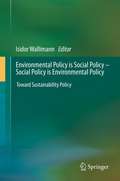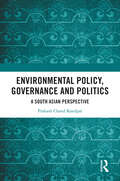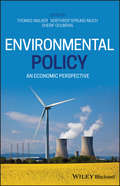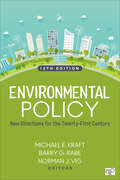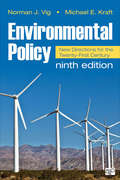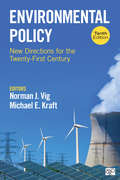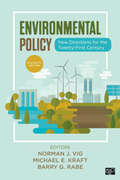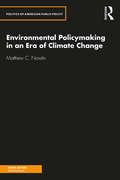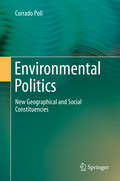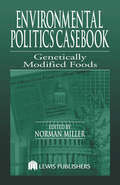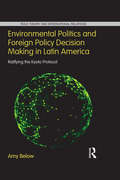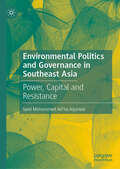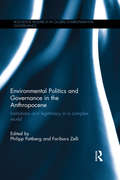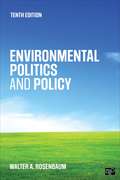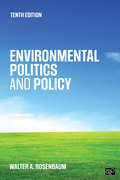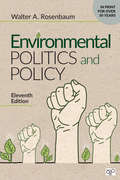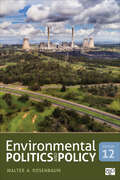- Table View
- List View
Environmental Policy in the EU: Actors, institutions and processes
by Andrew Jordan Camilla AdelleThe European Union (EU) has a hugely important effect on the way in which environmental policies are framed and implemented in many different parts of the world, but especially Europe. The new and comprehensively revised edition of this well-known textbook provides a state-of-the-art analysis of all the EU’s environmental policies. Comprising five parts, it covers the rapidly changing context in which EU environmental policies are made, the key actors who interact to co-produce policy and the most salient dynamics of policy making, ranging from decision making through to implementation and evaluation. Written by leading experts in the field, individual chapters examine how the EU is responding to a multitude of different problems including biodiversity loss, climate change, energy insecurity, and water and air pollution. They tease out the many important ways in which the EU's policies on these topics co-evolve with national and international environmental policies. In this third edition a mixture of learning features are employed to ensure that undergraduate and postgraduate students fully understand how EU policies in this vital area developed in the past and how they are now adapting to the rapidly evolving challenges of the twenty-first century.
Environmental Policy is Social Policy – Social Policy is Environmental Policy
by Isidor WallimannThis book argues that social and environmental policy should be synthetically treated as one and the same field, that both are but two aspects of the same coin - if sustainability is the goal. Such a paradigm shift is indicated, important, and timely to effectively move towards sustainability. This book is the first to take this approach and to give examples for it. Not to synthetically merge the two fields has been and will continue to be highly insufficient, inefficient and contradictory for policy and public administration aiming for a transformation towards a sustainable world. In general, social problems are dealt with in one "policy corner" and environmental problems in another. Rarely is social policy (at large) concerned with its impact on the environment or its connection with and relevance to environmental policy. Equally, environmental problems are generally not seen in conjunction with social policy, even though much environmental policy directly relates to health, nutrition, migration and other issues addressed by social policy. This book intends to correct the pattern to separate these very significant and large policy fields. Using examples from diverse academic and applied fields, it is shown how environmental policy can (and should) be thought of as social policy - and how social policy can (and should) simultaneously be seen as environmental policy. Tremendous benefits are to be expected.
Environmental Policy, Governance and Politics: A South Asian Perspective
by Prakash Chand KandpalThis book traces the development-environment discourse in India and examines the multi-layered interaction between society and nature in the light of the role of the state, judiciary and the civil society. Through an array of perspectives, the volume challenges the conventional approach to understanding the environmental politics in South Asia without considering the role of the civil society and other informal actors, which has radically altered the conventional articulation of the phenomenon.The volume underlines distinct structural characteristics of developmental politics in India and the social concerns and challenges which come in the way of environmental policy and governance in India. It is a meaningful intervention in unearthing significant socio-political and economic processes which are critical to the environmental governance in India. The book will not only be helpful in studying the state of policy, administration and politics of environmental discourse in India, but also guide the policymakers to explore the sustainable ways of environmental governance in South Asia.Insightful and lucid, this book will be useful to the students, researchers and faculty working in the field of political science, public administration, public policy, political sociology, political economy and governance studies. It will also be an invaluable and interesting reading for those interested in South Asian studies.
Environmental Policy: An Economic Perspective
by Thomas Walker Northrop Sprung-Much Sherif GoubranEXPAND YOUR UNDERSTANDING OF HOW ENVIRONMENTAL POLICY AFFECTS BUSINESS, THE ECONOMY, AND YOUR LIFE WITH THIS ESSENTIAL RESOURCE Environmental Policy: An Economic Perspective offers readers a comprehensive examination of the ever-broadening scope and impact of environmental policy, law, and regulation. Editors Thomas Walker, Northrop Sprung-Much, and Sherif Goubran walk readers through a variety of subjects while maintaining a global perspective on the expanding role of environmental law. This book takes a pragmatic and practical approach to its subject matter, showing readers the real impact across the world of different kinds of environmental policy. Among other topics, Environmental Policy: An Economic Perspective tackles: Climate change legislation Water conservation and pricing Biodiversity of the marine environment Wildlife ranching Emission trading schemes Green job strategies Sustainable investing Written for undergraduate and graduate students in any field affected by environmental legislation and policy, this book also belongs on the shelves of anyone who seeks to better understand the increasingly important role of environmental policy on their business and life.
Environmental Policy: Implementation and Enforcement (Routledge Revivals)
by Neil HawkeThis title was first published in 2002. Environmental Policy is an astute and far-reaching text which analyzes the intersections between environmental policy formation and its ultimate implementation and enforcement through the law. It sets this theme against the axis of EU law and policy and UK law and policy, paying particular attention to the variables which determine the nature and significance of law as a delivery vehicle . Among these variables are the shape and character of EU and UK law for present purposes, alternatives to law, and the culture of UK law and policy aiding a distinct pattern of response to Directives, for example. It takes an informed look at the reality of implementation and enforcement through its reference to policy objectives as well as the limits and appropriateness of law across the aforementioned axis . An indispensable resource for scholars and students of environmental law and policy, along with governmental and other environmental agencies responsible for policy creation, implementation and enforcement.
Environmental Policy: New Directions for the Twenty-First Century
by Barry G. Rabe Michael E. KraftAs environmental issues continue to become more prevalent in society and surrounding policy challenges become more complex, Environmental Policy once again brings together top scholars to evaluate the changes and continuities in American environmental policy since the late 1960s and their implications for current policy. Students will learn to decipher the underlying trends, institutional constraints, and policy dilemmas that shape today’s environmental politics as they evaluate approaches to future challenges.
Environmental Policy: New Directions for the Twenty-First Century
by Barry G. Rabe Michael E. KraftAs environmental issues continue to become more prevalent in society and surrounding policy challenges become more complex, Environmental Policy once again brings together top scholars to evaluate the changes and continuities in American environmental policy since the late 1960s and their implications for current policy. Students will learn to decipher the underlying trends, institutional constraints, and policy dilemmas that shape today’s environmental politics as they evaluate approaches to future challenges.
Environmental Policy: New Directions for the Twenty-First Century
by Mr Michael E. Kraft Mr Norman J. VigAuthoritative and trusted, Environmental Policy convenes top scholars to evaluate the impact of past environmental policy while anticipating its future implications, helping students decipher the underlying trends, institutional constraints, and policy dilemmas that shape environmental politics. In the Ninth Edition, editors Norman Vig and Michael Kraft offer coverage of the latest issues, including the energy and natural resource policy dilemmas, sustainable cities, and the environmental impact of food production and consumption. A new concluding chapter ties the contributed material together with an assessment of the remaining environmental policy challenges for the 21st century.
Environmental Policy: New Directions for the Twenty-First Century
by Mr Michael E. Kraft Mr Norman J. VigAuthoritative and trusted, Environmental Policy convenes top scholars to evaluate the impact of past environmental policy while anticipating its future implications, helping students decipher the underlying trends, institutional constraints, and policy dilemmas that shape environmental politics. In the Ninth Edition, editors Norman Vig and Michael Kraft offer coverage of the latest issues, including the energy and natural resource policy dilemmas, sustainable cities, and the environmental impact of food production and consumption. A new concluding chapter ties the contributed material together with an assessment of the remaining environmental policy challenges for the 21st century.
Environmental Policy: New Directions for the Twenty-First Century
by Mr Michael E. Kraft Mr Norman J. VigAuthoritative and trusted, Environmental Policy once again brings together top scholars to evaluate the changes and continuities in American environmental policy since the late 1960s and their implications for the twenty-first century. You will learn to decipher the underlying trends, institutional constraints, and policy dilemmas that shape today’s environmental politics. The Tenth Edition examines how policy has changed within federal institutions and state and local governments, as well as how environmental governance affects private sector policies and practices. The book provides in-depth examinations of public policy dilemmas including fracking, food production, urban sustainability, and the viability of using market solutions to address policy challenges. Students will also develop a deeper understanding of global issues such as climate change governance, the implications of the Paris Agreement, and the role of environmental policy in the developing world. Students walk away with a measured yet hopeful evaluation of the future challenges policymakers will confront as the American environmental movement continues to affect the political process.
Environmental Policy: New Directions for the Twenty-First Century
by Mr Michael E. Kraft Mr Norman J. VigAuthoritative and trusted, Environmental Policy once again brings together top scholars to evaluate the changes and continuities in American environmental policy since the late 1960s and their implications for the twenty-first century. You will learn to decipher the underlying trends, institutional constraints, and policy dilemmas that shape today’s environmental politics. The Tenth Edition examines how policy has changed within federal institutions and state and local governments, as well as how environmental governance affects private sector policies and practices. The book provides in-depth examinations of public policy dilemmas including fracking, food production, urban sustainability, and the viability of using market solutions to address policy challenges. Students will also develop a deeper understanding of global issues such as climate change governance, the implications of the Paris Agreement, and the role of environmental policy in the developing world. Students walk away with a measured yet hopeful evaluation of the future challenges policymakers will confront as the American environmental movement continues to affect the political process.
Environmental Policy: New Directions for the Twenty-First Century (The\harpercollins Public Policy Ser.)
by Barry G. Rabe Michael E. Kraft Norman J. VigAuthoritative and trusted, Environmental Policy once again brings together top scholars to evaluate the changes and continuities in American environmental policy since the late 1960s and their implications for the twenty-first century. Students will learn to decipher the underlying trends, institutional constraints, and policy dilemmas that shape today’s environmental politics. The Eleventh Edition examines how policy has changed within federal institutions and state and local governments, as well as how environmental governance affects private sector policies and practices. There are five new chapters in this edition that examine the public’s opinion on the environment, courts, energy policy, natural resource agencies and policies, and the political economy of green growth. The book has been updated to reflect the Trump administration′s four years of policy changes and students will walk away with a measured, yet hopeful evaluation of the future challenges that policymakers will confront as the American environmental movement continues to affect the political process.
Environmental Policy: New Directions for the Twenty-First Century (The\harpercollins Public Policy Ser.)
by Barry G. Rabe Michael E. Kraft Norman J. VigAuthoritative and trusted, Environmental Policy once again brings together top scholars to evaluate the changes and continuities in American environmental policy since the late 1960s and their implications for the twenty-first century. Students will learn to decipher the underlying trends, institutional constraints, and policy dilemmas that shape today’s environmental politics. The Eleventh Edition examines how policy has changed within federal institutions and state and local governments, as well as how environmental governance affects private sector policies and practices. There are five new chapters in this edition that examine the public’s opinion on the environment, courts, energy policy, natural resource agencies and policies, and the political economy of green growth. The book has been updated to reflect the Trump administration′s four years of policy changes and students will walk away with a measured, yet hopeful evaluation of the future challenges that policymakers will confront as the American environmental movement continues to affect the political process.
Environmental Policymaking in an Era of Climate Change
by Matthew C. NowlinAs the world considers how to deal with the impacts of a changing climate, it’s vital that we understand the ways in which the United States’ policymaking process addresses environmental issues. A mix of existing theory and original analysis, Environmental Policymaking in an Era of Climate Change applies recent policy scholarship to questions of environmental governance, with a particular focus on climate change. The book examines how competing political actors influence policies within and across institutions, focusing on both a macro-level, where formal bodies set the agenda, and a meso-level, where issues are contained within policy subsystems. Divided into two sections, the book incorporates insights from political science and public policy to provide the reader with a better understanding of how environmental policy decisions are made. Part I offers a framework for understanding environmental policymaking, exploring the history of environmental policy, and discussing the importance of values in environmental policy. Part II applies the framework to the issue of climate change, focusing on agenda-setting and the role of formal institutions in the policymaking process, covering topics that include Congress, the Executive and Judicial branches, and how climate change cuts across policy subsystem boundaries. By placing specific climate change case studies in a broader context, Environmental Policymaking in an Era of Climate Change will help students enrolled in political science, public administration, public policy, and environmental studies courses – as well as all those interested in the impacts of policy on climate change – to understand what is, and will likely continue to be, one of the most pressing policy issues of our time.
Environmental Politics
by Corrado PoliA change in the way humans relate to nature could be the starting point for a new politics, which will also affect relations among humans. A new approach would help to radically transform the production system, not because it is unjust in the usually considered social terms, but because it endangers nature and humanity. So far, the citizens' grassroots organizations have failed to win broad consensus and political power in the representative institutions. When the time comes to transform the single environmental issue into an electoral platform, environmentalists lose unity and effectiveness since they lack a common political vision and an ensuing strategy. On the other hand European politics is rapidly transforming because the challenge brought by so-called populist movements. We need to transform activists' shared emotions and attitudes into political ideologies and platforms. Moreover, a new educational process and a new science politics are necessary to reform environmental policy.
Environmental Politics Casebook: Genetically Modified Foods
by Norman MillerEnvironmental Politics Casebook: Genetically Modified Foods includes testimony, journal and newspaper articles, book chapters, and interest group communications such as press releases and on-line briefs, as well as other studies and reports that constitute the principal elements of the public debate on the genetic modification of food. A companion
Environmental Politics and Foreign Policy Decision Making in Latin America: Ratifying the Kyoto Protocol (Role Theory and International Relations)
by Amy BelowAlthough the Kyoto Protocol, an international agreement to address global climate change, has been regarded by many as an unsuccessful treaty both politically and environmentally, it stands as one of the world’s few truly global agreements. Why did such a diverse group of countries decide to sign and/or ratify the treaty? Why did they choose to do so at different times and in different ways? What explains their foreign policy behavior? Amy Below’s book builds off the increasing significance of climate change and uses the Kyoto Protocol as a case study to analyze foreign policy decision making in Latin America. Below’s study takes a regional perspective in order to examine why countries in Latin America made disparate foreign policy choices when they were faced with the same decision. The book looks at the decisions in Argentina, Mexico, and Venezuela via a process-tracing method. Below uses information obtained from primary and secondary documents and elite interviews to help reconstruct the processes, and augments her reconstruction with a content analysis of Conference of the Parties speeches by presidents and country delegates. The book complies with convention in the field by arguing that systemic, national and individual-level factors simultaneously impact foreign policy decisions, but makes the additional claim that role theory most accurately accounts for relationships between variables. Environmental Politics and Foreign Policy Decision Making in Latin America considers a variety of factors on individual, national, and international levels of analysis, and show that the foreign policy decisions are best viewed through the prism of role theory. The book also draws conclusions about the value of role theory in general and about environmental foreign policy decisions in developing countries, which will be of value to both policy-makers and academics.
Environmental Politics and Governance in Southeast Asia: Power, Capital and Resistance
by Syed Mohammed AljuniedIn this book, Aljunied analyses how ASEAN and its key maritime member states of Singapore, Malaysia and Indonesia govern environmental issues through strategic engagements with social forces.In the new millennium, ASEAN states&’ power is enhanced and solidified through regulatory statehood, strategic renewal and moral ideology in order to subdue civil resistance while managing non-traditional security threats. Through a comparative analysis of Southeast Asia, this book highlights how state-capitalist-society relations are shaped by politics of scale and social conflict in order to reinforce authoritarianism and intensify capitalism development agendas at the expense of environmental preservation.With this, the book explores how civil society challenge and are suppressed by state power at national and regional platforms. A pioneering scholarly work, this book represents a major contribution to the intersection between political science, environmental governance and Southeast Asian Studies by offering rich theoretical and empirical insights into the dynamics of state-capitalist-society relations in an era of global environmental crisis.
Environmental Politics and Governance in the Anthropocene: Institutions and legitimacy in a complex world (Routledge Research in Global Environmental Governance)
by Fariborz Zelli Philipp PattbergThe term Anthropocene denotes a new geological epoch characterized by the unprecedented impact of human activities on the Earth’s ecosystems. While the natural sciences have advanced their understanding of the drivers and processes of global change considerably over the last two decades, the social sciences lag behind in addressing the fundamental challenge of governance and politics in the Anthropocene. This book attempts to close this crucial research gap, in particular with regards to the following three overarching research themes: (i) the meaning, sense-making and contestations emerging around the concept of the Anthropocene related to the social sciences; (ii) the role and relevance of institutions, both formal and informal as well as international and transnational, for governing in the Anthropocene; and (iii) the role and relevance of accountability and other democratic principles for governing in the Anthropocene. Drawing together a range of key thinkers in the field, this volume provides one of the first authoritative assessments of global environmental politics and governance in the Anthropocene, reflecting on how the planetary scale crisis changes the ways in which humans respond to the challenge. This volume will be of great interest to students and scholars of global environmental politics and governance, and sustainable development.
Environmental Politics and Policy
by Walter A. RosenbaumThis book covers the context of the environmental policy process, as well as exploring specific environmental issues. It examines topics such as toxic and hazardous substances; energy - both fossil fuel and nuclear' public lands; and global policy-making ocusing on climate change and transboundary politics.
Environmental Politics and Policy
by Walter A. RosenbaumWalter A. Rosenbaum’s classic Environmental Politics and Policy, Tenth Edition once again provides definitive coverage of environmental politics and policy, lively case material, and a balanced assessment of current environmental issues. The first half of the book sets needed context and describes the policy process while the second half covers specific environmental issues such as air and water; toxic and hazardous substances; energy; and a global policymaking chapter focused on climate change and transboundary politics. Covering major environmental policy initiatives and controversies during President Obama's two terms and capturing the sudden and radical changes occurring in the American energy economy, this Tenth Edition offers the needed currency and relevancy for any environmental politics course.
Environmental Politics and Policy
by Walter A. RosenbaumWalter A. Rosenbaum’s classic Environmental Politics and Policy, Tenth Edition once again provides definitive coverage of environmental politics and policy, lively case material, and a balanced assessment of current environmental issues. The first half of the book sets needed context and describes the policy process while the second half covers specific environmental issues such as air and water; toxic and hazardous substances; energy; and a global policymaking chapter focused on climate change and transboundary politics. Covering major environmental policy initiatives and controversies during President Obama's two terms and capturing the sudden and radical changes occurring in the American energy economy, this Tenth Edition offers the needed currency and relevancy for any environmental politics course.
Environmental Politics and Policy
by Walter A. RosenbaumWalter A. Rosenbaum’s classic Environmental Politics and Policy provides definitive coverage of environmental politics and policy, lively case material, and a balanced assessment of current environmental issues. The first half of the book sets needed context and describes the policy process while the second half covers specific environmental issues such as air and water; toxic and hazardous substances; energy; and a global policymaking chapter focused on climate change and trans-boundary politics. The eleventh edition includes updates on the Trump administration's initiatives and controversies with regard to environmental policy, offering the currency and relevancy needed for any environmental politics course.
Environmental Politics and Policy
by Walter A. RosenbaumWalter A. Rosenbaum’s classic Environmental Politics and Policy provides definitive coverage of environmental politics and policy, lively case material, and a balanced assessment of current environmental issues. The first half of the book sets needed context and describes the policy process while the second half covers specific environmental issues such as air and water; toxic and hazardous substances; energy; and a global policymaking chapter focused on climate change and trans-boundary politics. The eleventh edition includes updates on the Trump administration's initiatives and controversies with regard to environmental policy, offering the currency and relevancy needed for any environmental politics course.
Environmental Politics and Policy
by Walter A. RosenbaumWalter A. Rosenbaum′s classic Environmental Politics and Policy, Twelfth Edition, provides definitive coverage of environmental politics and policy, lively case material, and a balanced assessment of current environmental issues. The newly streamlined first half of the book sets needed context and describes the policy process, while the second half covers specific environmental issues such as air and water, toxic and hazardous substances, energy, and global policymaking on issues like climate change and trans-boundary politics. The Twelfth Edition includes updated case studies and a look at the transition in environmental policies between the Trump and Biden administrations, offering students a current and relevant look at the continuing challenge of reconciling sound science with practical politics.

